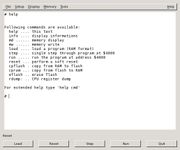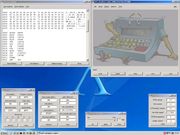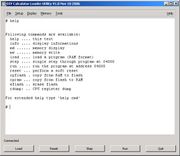DIY-Calculator Hardware:Upload Utility Project
From DIY-Calculator_Hardware
| Revision as of 18:54, 11 November 2006 Jh (Talk | contribs) ← Previous diff |
Revision as of 08:31, 12 November 2006 Hzulu (Talk | contribs) Next diff → |
||
| Line 43: | Line 43: | ||
| </div> | </div> | ||
| </div> | </div> | ||
| - | |||
| - | <div style="border:0; margin: 20px 20% 0px 0px;"> | ||
| <div style="background:#f9f9f9; padding:0; border:1px solid #aaaaaa; margin-bottom:15px;"> | <div style="background:#f9f9f9; padding:0; border:1px solid #aaaaaa; margin-bottom:15px;"> | ||
| Line 54: | Line 52: | ||
| </div> | </div> | ||
| </div> | </div> | ||
| - | |||
| - | <div style="border:0; margin: 20px 20% 0px 0px;"> | ||
| <div style="background:#f9f9f9; padding:0; border:1px solid #aaaaaa; margin-bottom:15px;"> | <div style="background:#f9f9f9; padding:0; border:1px solid #aaaaaa; margin-bottom:15px;"> | ||
Revision as of 08:31, 12 November 2006
The user program upload process is handled by the ROM monitor on the DIY Calculator side. But there must be a means of sending a program to the DIY Calculator. While it is possible to send a file with the terminal emulation program a GUI program is preferable. Furthermore, by having a dedicated program for this task it is possible to generate a check sum or use a protocol of choice for ensuring correct transmission. The transmission status (success/failure) can be displayed. This program should be written in "C" using the GTK library of GUI widgets to be easily ported to different platforms.
Project status (11.Nov.2006):
It enables you to do the following via graphical user interface:
- load a user program to the DIY Calculator hardware
- save the user program into onboard flash memory
- run the user program
- single step through the user program
- display and update CPU registers during single step
- view an arbitrary area of memory of the DIY Calculator
- select a hexdump or a disassembler view
- purge the DIY Calculator's memory
- display the most important I/O ports
- select the CPU speed. Caution: When setting the CPU clock speed to real slow values (ca. < 1MHz), the communication between the DIY Calculator hardware and the Loader application is not guaranteed to work reliable!
- open a terminal to the DIY Calculator hardware
The application is available both in Windows and Linux. It requires the GTK Widgets runtime library, version 2.6.4 or newer. Linux users will most likely have already installed GTK, Windows users may download the latest runtime from here: [1].
View more screen shots:
Linux:
Windows:
Plus for those who can't wait: We created a simulator program that simulates the real hardware responses. Just connect the two communication ports of your PC via a null modem or connect two PCs via null modem, start the simulator program and try out the DIY Calculator Loader application. Be aware that this is 'not' a CPU simulator (you already have this with the Virtual DIY Calculator); it just simulates the ROM monitor responses. diy_sim-1.0-src.zip
Please view the README file.
For other updates visit the other sections: Hardware Project; ROM Monitor Project
Project status (7.Nov.2006):
A lot has happened since the last update. The loader application has made great progress.
Project status (12.Oct.2006):
work started
Project status (19.Jul.2006):
considered






